[Original by Yuna TAMAMURA, an intern on the “Korea Children Campaign,” the Relief Campaign Committee for Children, Japan (March 23, 2021); Translated by H. Ueda/M. Olagoke]
Thank you for your interest in my report. I am Tamamura, an intern on the Korea Children Campaign. Under the global pandemic, how are you doing, everyone? I’m making a report of the tour of the Okubo area, Shinjuku, which we conducted in the fall of 2020 taking measures to prevent the infection of COVID-19.
We walked around downtown of the Okubo area, sometimes stopping at and dropping by places with exposed traces of historical struggles which we had so far passed by unnoticed. At each point, our instructor told us a relevant story which we thought about and discussed together. I hope this article will provide you with a chance to jump into an unknown world led by nondescript walkways or school roads.
What is the Northeast Asian University Peace Exchange Program?
Its activities include holding networking events, study sessions and doing fieldworks in an effort to establish peace in the Northeastern Asian region. In 2020, however, no activities had been performed due to the COVID-19 epidemic. Under the rough times, however, students have been studying the history of Japan and the Korean peninsula, the current situation of Zainichi (Korean nationals living in Japan), and the problems in the relationship between Japan and North Korea and between Japan and South Korea.
Light and shadow of downtown
Our tour started from a deserted street in Shinjuku early in the morning. Participants from the Kanto area who became members in 2020 met face to face for the first time. It must have been a break for the student members to go outside, who had long been locked inside their houses and took online lessons. Masked faces surrounded the instructor Mr. Ishizaka and looked into his face, listening intently to what he was saying. It was the most impressive scene to me.
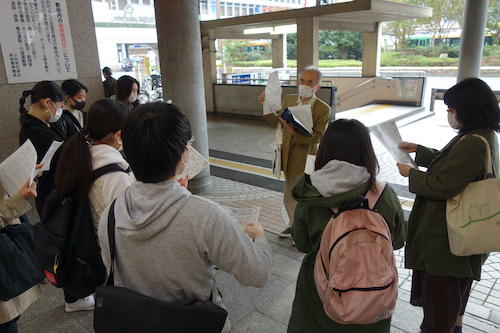
On a calm Saturday morning, participants were given an itinerary and cautions for the day.
First, we visited a Korean restaurant and a street where there used to be a black market. We found remains of lives which had been important for Korean nationals living in Japan, including black markets and brothels operated in the postwar period by them. It was a surprise that those remains had been regenerated into new buildings to support new modern lives.
Voices of surprise came from here and there. Some said, “I’ve been here before, but I didn’t know that such things happened here,” and others said, “So, this is where it has been.” With the spread of map applications, we no longer make a detour, stop by unexpected places, or look away from the smartphone to look around the cityscape. We are always provided the shortest and perfect route. Perhaps such landmarks might have been overlooked because people are instead being attracted to neon lights at night.
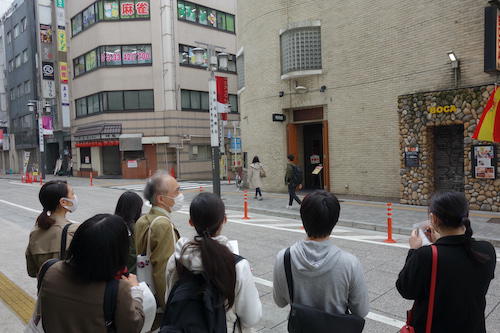
Korean restaurant Meigetsukan. It started at a place which used to be a black market. The restaurant was known as the source of nutrients for the activists of the General Association of Korean Residents. Its founder is said to have provided plenty of food free of charge for the activists, saying “Eat as much as you want.”
The usual landscape of Shinjuku gradually began to look different. When we walked in the direction of the Okubo area, the formation of participants which had so far progressed in an orderly manner suddenly got confused as each of them started saying, “There is a sign written in Korean over there”, “I found a sign written in Hindi,” etc. We observed the Okubo area where various cultures coexist from each perspective, shared opinions at each spot, thereby increasing detours and stand-talking on our way.
When we passed through a residential area where several languages were heard, the gorgeous Ma Zhu Miao which was said to have been built by Taiwanese immigrants, came into view and prompted voices of admiration among the participants. The lofty landmark overturned our impression of Okubo, which is known as a Korea town where streets are lined with Korean restaurants and K-pop music. We changed our perception about Okubo and moved forward, discussing the history of the area: who moved in, how the area developed, and how Okubo residents with diversified backgrounds live side by side.
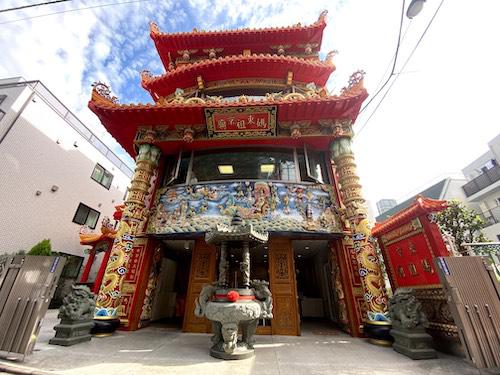
Ma Zhu Miao. Ma Zhu is a Guardian God which can be seen in the regions facing the sea in the Fujian Province, China. Ma Zhu Miao in Okubo has been established relatively recently. The monument indicates that the south-eastern side of Okubo Station used to be the residential area of Taiwanese immigrants.
Then we visited a housing exhibition hall constructed on the old Lotte factory site, the Korean plaza which exists even now, and JINGA, a Korean restaurant which started in the early 1990s. JINGA was the first Korean restaurant recognized by the Japanese people. These made us think about the future of the Okubo area, wondering which buildings will remain and which will disappear.
Lastly, we walked around the quiet Toyama Park immediately after getting out of busy downtown. We came across the Military Academy’s dormitory that was built in 1873 on the remains of the suburban residence of the Owari clan. It then became Toyama Military Academy in 1874. Jiro Minami, the former Governor-General of Korea and Army General, had a residence near here. He issued an order for Koreans living in Japan to change their names to Japanese ones. Nobuyuki Abe, the Army General and the last Governor-General of Korea before the end of World War II, also lived nearby. In the two-hour tour, some got tired as they spent time outdoors for the first time in a while, while others needed more time as their interests were ignited through several discussions.
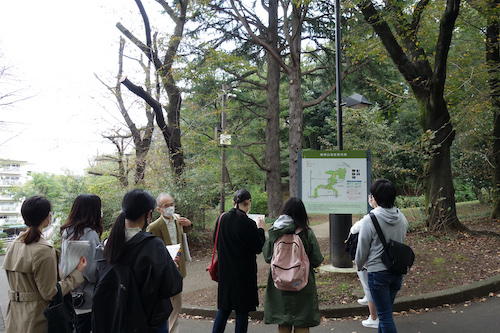
Participants are getting information of the history of the surrounding area at Toyama Park. Mt. Hakone located inside the park with an elevation of 44.6 m is the highest mountain in the area surrounded by the JR Yamanote line.
Stop walking and make a detour
This tour provided us a huge potential for learning history. Before the onset of the pandemic, we focused on the world stage, flying around the world freely, performing dynamic activities and investigations, almost forgetting the significance of domestic activities. Now, being isolated from the world, this is the best opportunity for us to review the history in our neighborhood and think about the multicultural symbiosis, which I believe will be useful in the future for global cooperation.
Besides the Okubo area, there must be many other areas in our neighborhood where we can find the scars of history. If we stop for a minute and look around, clues must be hidden to help us look back and think about a better future.
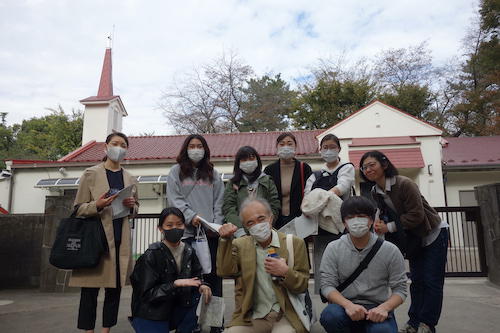
Commemorative group photo. Thank you very much, Ishizaka-sensei.
